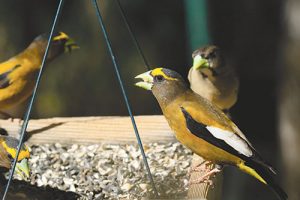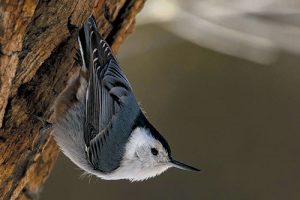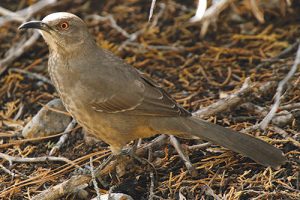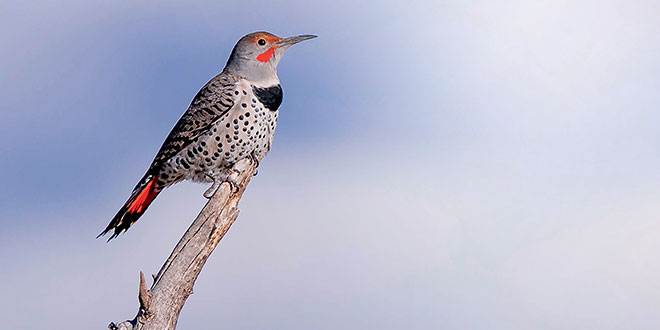Ditch screen time for your window
Bird alert! This is a note of fair warning before proceeding. The activities encouraged in this article could lead to an obsession with birds, feeding birds and identifying birds. Major side effects could result in a severe reduction in time spent staring at screens!
If you already are one of the 59 million Americans feeding and watching birds you may be chuckling, but others may ask what the big deal is and why feed birds? Especially in winter when it is cold outside?
Feeding and inviting birds into our yards is more for our own enjoyment. Birds will almost always do fine without our feeders filled up. However, a bird-friendly yard for resident and migratory birds can make a difference in their survival. Watching birds is fun, reduces stress and connects us with wildlife and other people.



Banner: Northern Flicker. Department photo by Brad Ryan.
Top: Evening Grosbeaks. Department photo by Mark Watson.
Center: White-breasted Nuthatch. Department photo by Brad Ryan.
Bottom: Curve-billed Thrasher. Department photo by Mark Watson.
It is relatively easy to begin seeing amazing birds in your backyard. First, purchase or make a basic, hanging feeder that keeps food dry and from spilling out too easily. Second, buy a large plastic shallow bird bath or large potted plant base. Put the bird bath on a stable platform about 4-5 feet off the ground in an open area where birds can see potential predators (like cats, Coopers and Sharp-shinned hawks) and where you can see them. Do the same for the feeder (a shepherd hook works well for open spots) or hang off roof eaves. The main thing is that it is fairly open and that you can see them.
What to feed birds? Your choice depends on where you are and to some extent which birds you want to attract. For over 30 bird species in New Mexico, and for your pocketbook, black oil sunflower seeds attract the widest variety of birds— especially if you don’t mind cleaning up fallen shells underneath.
If you live in southern New Mexico and see birds like Gambel Quail, doves, Canyon Towhee or Dark-eyed Junco then milo or millet mixed with black oil sunflower seeds is rewarding. If it is cold enough during the day, hang out suet or peanut butter to attract Downy, Hairy and Ladder-backed Woodpeckers, Northern Flickers, Juniper Titmouse, Bushtit, Mountain Chickadees and Woodhouse’s Scrub Jay (formerly Western Scrub Jay).
Peanut hearts are more expensive but they are loved by over 50 species of birds in New Mexico including chickadees, nuthatches, woodpeckers, Mourning Dove, Juniper Titmouse and Spotted Towhee. For many Santa Fe residents, Woodhouse’s Scrub Jay seem to prefer peanuts in shell and occasionally suet. Experiment and see what works best for your feeders.
Once you start attracting birds it is important to protect them from our actions. Keep the ground below feeders clean of hulls and soak or scrub feeders regularly. Use a diluted bleach solution, rinse them thoroughly and let them dry before adding bird feed. Prevention is the key to avoiding the spread of disease such as avian pox and salmonellosis. Clean your feeders regularly even when there are no signs
of disease.
Providing a clean bird bath in the winter is especially helpful for birds to drink and to clean feathers of dust and grime. Clean feathers allow them to stay fluffed up and warm overnight. Birds you may see at a bird bath but not winter feeders include; American Robin, Curve-billed Thrasher, Canyon Towhee, Yellow-rumped Warbler and Western Bluebird.
If you have cats the best for their safety and for birds you attract is to keep them indoors or watch when they are outside. Even well-fed, vaccinated cats will hunt for birds and other wildlife. Recent studies estimate a minimum of 1.3 billion birds are killed annually by free-roaming cats.
If you observe carefully, you may never tire of your usual visitors. When uncommon or rare birds arrive like Brown Creeper, White-breasted Nuthatch, Bushtits or a flock of Evening Grosbeaks it will be even more exciting.
To learn more about birds and feeding birds, visit the Cornell Lab of Ornithology sponsored websites www.allaboutbirds.org and www.feederwatch.org
Snap pictures of birds and share them on our Facebook page ‘NM Game and Fish’ or public group ‘Birding New Mexico’. Get identification tips, suggestions on attracting birds and what birds your neighbors are seeing. Download the free Merlin Bird ID app for instant help in identifying your photo.
For more information about feeding birds and creating bird-friendly yards contact me at kevin.holladay@state.nm.us.
 New Mexico Wildlife magazine Conserving New Mexico's Wildlife for Future Generations
New Mexico Wildlife magazine Conserving New Mexico's Wildlife for Future Generations
